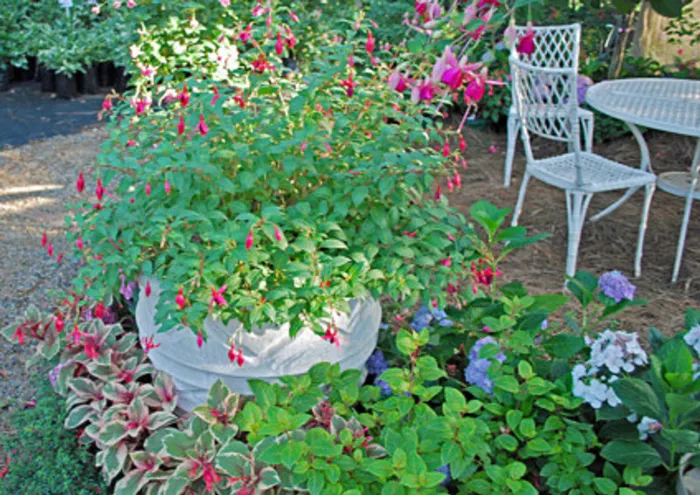Fabulous fuchsia feast

PRETTY IN A POT: Fuchsias do particularly well in a flower bed beside an east- or south-facing wall, under trees or large shrubs in filtered shade or in containers on a patio. PRETTY IN A POT: Fuchsias do particularly well in a flower bed beside an east- or south-facing wall, under trees or large shrubs in filtered shade or in containers on a patio.
It’s a time to experiment by acquiring your first fuchsia, add to a collection of garden fuchsias or simply make the most of your favourite hanging basket.
Here are a few tips for fuchsia lovers this weekend.
Where do I put a fuchsia?
“Fuchsias do particularly well in a flower bed beside an east- or south-facing wall, under trees or large shrubs in filtered shade or in containers on a patio,” says fuchsia expert Beth Middleton.
If you plan to pot up a fuchsia, make sure the container has a diameter of at least 25cm.
On the patio, you can enjoy the summer flowers, but more importantly, they will be close enough for you to watch their progress. You’ll be able to see if they need water or need dead flowers removed.
“Fuchsias need good light to flower well. Dense shade inhibits flowering and promotes lanky growth. Although there are a few sun-tolerant fuchsias, in South Africa most varieties will burn if placed in the midday and harsh afternoon sun,” says Middleton.
Planting a fuchsia in the garden
Choose upright bush fuchsias for the garden. Dig a hole twice the size of the pot you have bought.
Keep the top half of the soil to one side and then mix into it a generous amount of compost, and a small handful of super phosphate.
Replace the lower half of soil in the hole. Remove the plant with its soil from its pot without disturbing the roots.
Place the plant on top of the soil and fill in with the pile of soil that contains compost and fertilisers.
How to water fuchsias
“Like roses, fuchsias are waterholics, but they hate wet feet. To avoid fuchsia roots sitting in water, make sure that you avoid planting them in potentially boggy zones or in containers that do not have good drainage,” she advises.
The soil around fuchsias must be allowed to dry out before they are soaked. Fuchsias can get root rot in gardens where irrigation systems keep the soil permanently drenched.
Feeding fuchsias
Nowis the time to take a good look at the fuchsias already in your garden. A profusion of healthy foliage and magnificent blooms are the direct result of a fertiliser programme. Sprinkle a small handful of the general fertiliser granules around each bush every four to six weeks from now until the beginning of March when growth starts slowing down.
Research has proved that plants can absorb fertiliser through their leaves. Known as foliage feeding, it’s a process which works particularly well with fuchsias and in fact all plants which compete with the roots of trees for nutrients in shady borders.
“Foliar feed fuchsias by spray- misting them with a dilution of Multifeed or Multisol 2:1:2 every two to three weeks to ensure continuous flowering and healthy growth from now until February,” says Middleton. Also, remember to mulch plants with a layer of compost after fertilising for the best results. Mulching keeps roots cool and moist in midsummer.
Choosing varieties
Consider these varieties this summer:
* Upright growth: Alison Patricia (red and pink – upward looking), Ernie (bright red and white), Reg Gubler (unusual shape, red and blue), Rohees King (red and purple, almost black).
* Lax growth: Red Shadows (red and purple), Pinto de Blue (white and blue), Charlie Girl (pink and lilac) and Drama Girl (pink and blue) all have large blooms.
* Trailing growth: Windhapper (creamy white and rose), Pink Marshmallow (pinkish/white), Red Spider (red), Land van Beveren (white and carmine).
Midsummer stress
“Just like hydrangeas, fuchsias display symptoms of stress when midsummer temperatures rise above 30ºC,” says Middleton. Cool them down with a fine spray mist of water on really hot days, but avoid drenching the soil with water.
In cases of heat stress, the leaves will revive at sunset. Over-watering a stressed fuchsia does more harm than help.
Beating white fly
The convenient answer to all problems of white fly and red spider is a garden aerosol called Wonder Gun. White flies breed on the third day of their life, so the secret is to break the breeding cycle and stop them multiplying.
Spray the undersides of all leaves on the first, third and eighth day. If the problem persists, start a spraying programme every two weeks using the same sequence. - Saturday Star